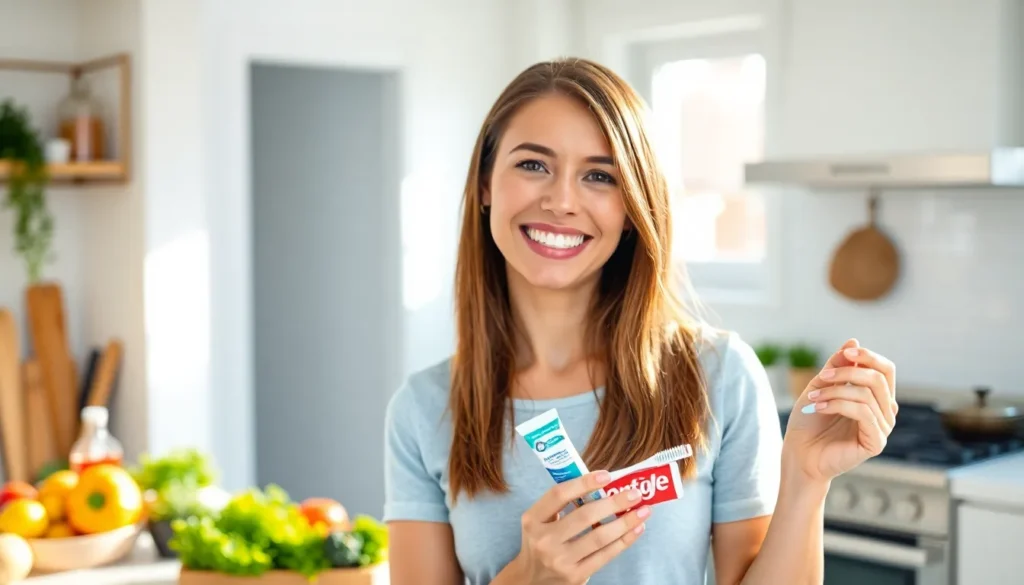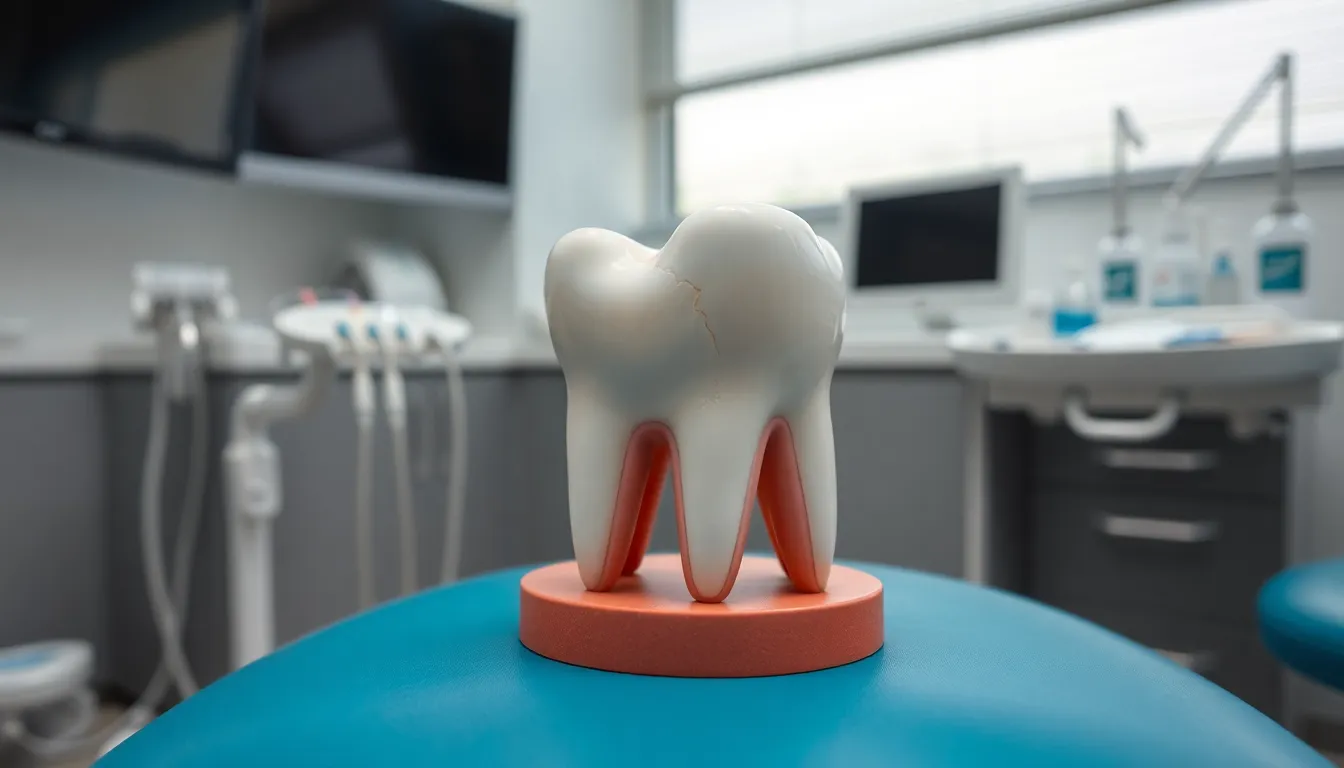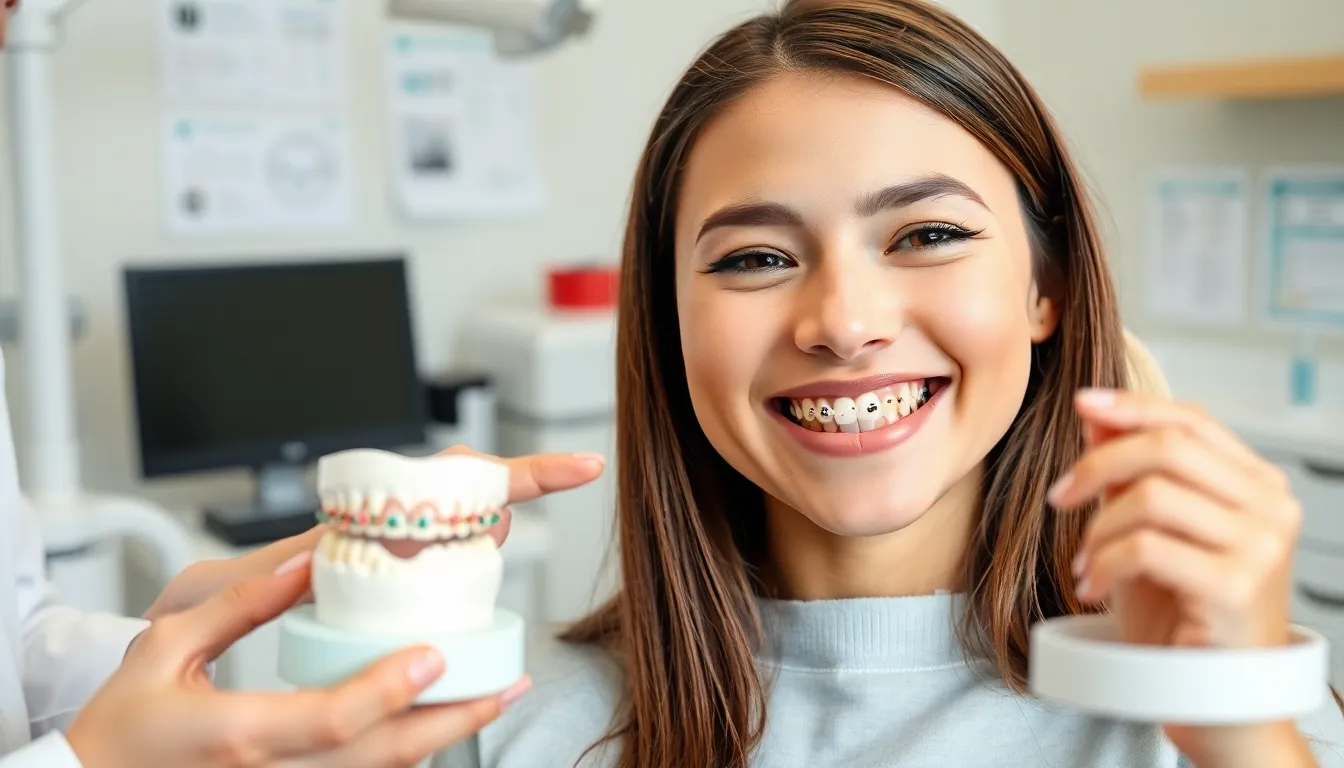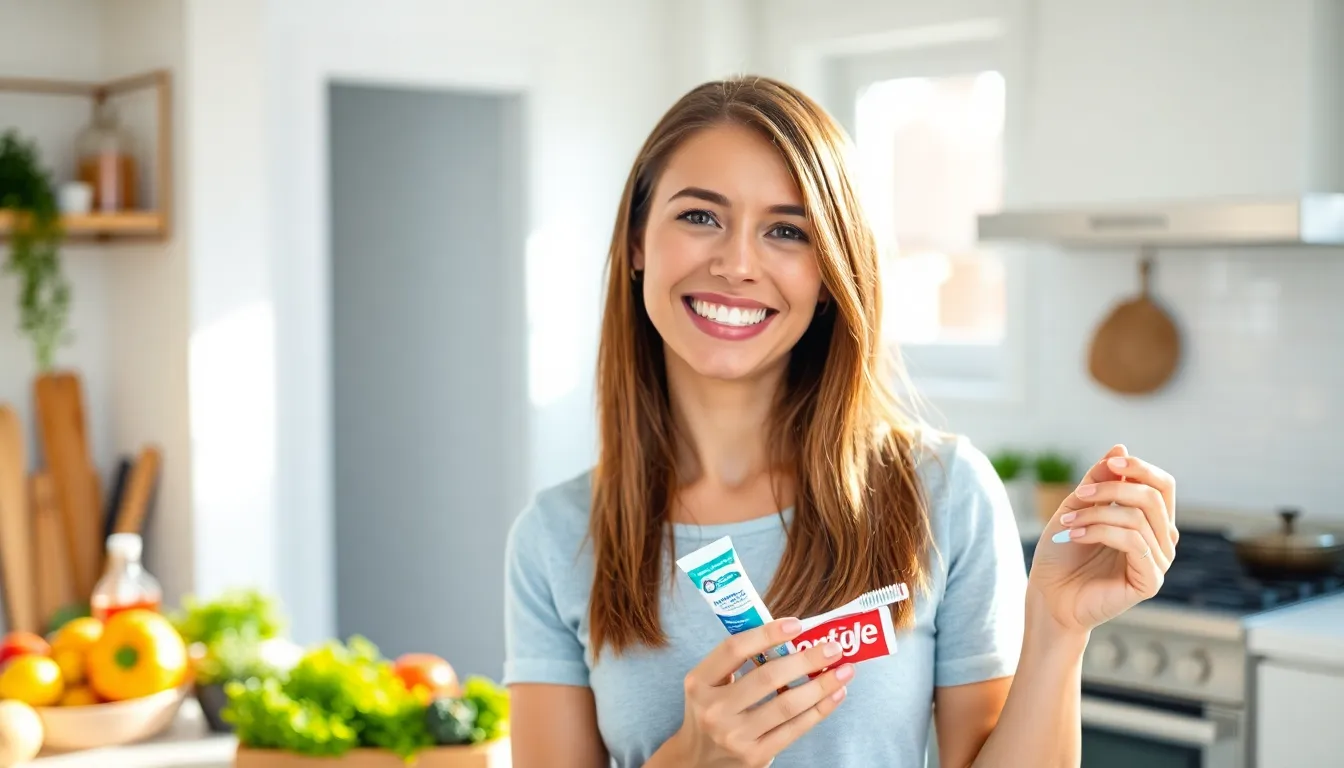Are you dreaming of sparkling teeth that light up your smile? That dazzling white smile isn’t just about aesthetics—it’s a powerful statement of health and confidence that can transform how you present yourself to the industry.
When your teeth sparkle, you’re more likely to show them off. Studies show that people with whiter teeth smile more frequently and are perceived as more professional and approachable. Whether you’re considering professional whitening treatments or searching for effective at-home answers, achieving that perfect gleam is more accessible than you might think.
What Makes Teeth Sparkle: Understanding Dental Enamel
Dental enamel forms the outer layer of your teeth, serving as nature’s shield against daily wear and tear. This remarkable substance is the hardest tissue in the human body, composed primarily of minerals like calcium phosphate. Enamel’s semi-translucent quality allows light to reflect off your teeth, creating that coveted sparkle when it’s healthy and intact.
The microstructure of enamel plays a crucial role in how light interacts with your teeth. Tiny rod-like structures within the enamel scatter and reflect light in various directions, contributing to the natural luminosity of teeth. When these structures remain uniform and undamaged, your smile appears brighter and more vibrant.
“I’ll never forget a patient named Sarah who came in devastated about her smile,” recalls Dr. Todd B. Harris. “After years of acidic beverages, her enamel had eroded significantly, leaving her teeth dull and yellow. Through a combination of remineralization treatments and protective measures, we restored the natural luster to her smile in just three months.”
Enamel thickness varies across different areas of your teeth, ranging from 2.5mm at the cusp to about 0.1mm near the gumline. This variation affects how light reflects off different parts of your teeth, creating natural highlights that enhance your smile’s appearance. Thicker enamel generally produces a whiter, more luminous appearance than thinner areas.
Environmental factors significantly impact enamel’s reflective properties. Consuming acidic foods and beverages can erode this protective layer, diminishing your teeth’s natural sparkle. Coffee, tea, red wine, and tobacco products deposit stubborn stains on the enamel surface, gradually dulling your smile’s brightness.
Age-related changes in enamel thickness and composition occur naturally over time. As you age, enamel gradually thins, revealing more of the yellowish dentin underneath. This natural process explains why older adults typically have teeth that appear more yellow or dull compared to younger individuals.
Common Causes of Dull or Discolored Teeth

Tooth discoloration occurs due to various factors that affect the natural sparkle of your smile. Understanding these causes helps you take appropriate preventive measures to maintain bright, vibrant teeth.
Food and Beverage Stains
Pigmented foods and drinks are primary culprits behind tooth discoloration as they penetrate the outer enamel layers. Coffee, tea, red wine, colas, and red sauces contain chromogens that attach to your tooth enamel, creating visible stains over time. Dark chocolates and certain fruits like blueberries and blackberries also contribute to dulling your smile’s brightness. Regular consumption of these items builds up staining compounds that diminish the reflective properties of your teeth.
Dr. Todd B. Harris notes, “I’ve seen patients who’ve cut coffee from their morning routine experience significantly whiter teeth within just a month. One memorable patient, a wine enthusiast, switched to white wine during social gatherings and saw remarkable improvement in her smile’s brilliance after only a few weeks.”
Tobacco Use and Medication Effects
Tobacco products dramatically impact tooth color through tar and nicotine deposits that create yellow or brown staining. Cigarettes, cigars, and chewing tobacco not only cause direct discoloration but also increase your teeth’s susceptibility to staining from other sources like coffee and tea. Studies show tobacco users experience a higher prevalence of tooth discoloration compared to non-smokers.
Certain medications can affect tooth color even when used as prescribed. Tetracycline antibiotics taken during childhood permanently stain developing teeth, creating intrinsic discoloration that’s difficult to address with standard whitening methods. Antihistamines, antipsychotics, and blood pressure medications may also contribute to dental discoloration as a side effect.
Many patients don’t realize their medications affect their smile until important changes have occurred. Chemotherapy and head and neck radiation can likewise alter tooth color by changing the composition of dental tissues.
Professional Teeth Whitening Options
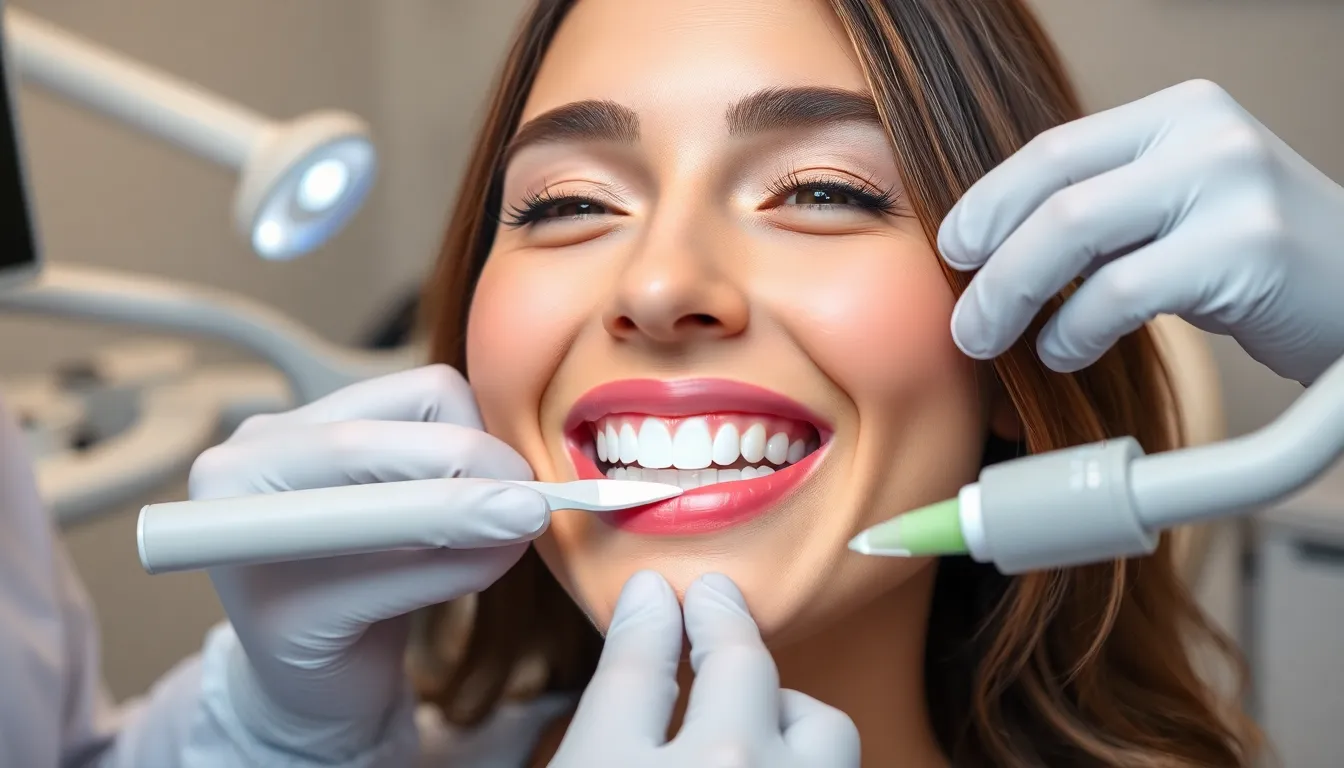
Professional teeth whitening delivers more dramatic results than over-the-counter alternatives, with treatments specifically designed to achieve that coveted sparkling smile. These professional options come in two main forms, each offering unique benefits depending on your preferences, timeline, and sensitivity levels.
In-Office Treatments
In-office whitening treatments provide immediate, dramatic results under direct dental supervision. Dental professionals apply high-concentration bleaching agents containing hydrogen peroxide or carbamide peroxide directly to your teeth in a controlled clinical environment. The whitening gel penetrates enamel to break down stubborn stains, while advanced technologies accelerate the process. Laser teeth whitening uses exact wavelengths to enhance the bleaching action with minimal impact on surrounding tissues. LED-activated systems employ cool blue light with adjustable settings to maximize comfort for patients with sensitivity concerns. Most patients notice a important improvement after just one 60-90 minute session, making this option perfect for anyone seeking quick results for an upcoming event.
Dr. Todd B. Harris shares, “Many of my patients are amazed by how groundbreaking a single professional whitening session can be. One executive client came in just three days before a major presentation and left with teeth several shades brighter—she later told me the confidence boost helped her secure a new business contract.”
Take-Home Professional Kits
Take-home professional kits combine convenience with customized dental care for gradual, consistent whitening. Your dentist creates custom-fitted trays designed to fit perfectly over your teeth, ensuring even application and minimizing gum irritation. These personalized trays come with professional-grade whitening gel at concentrations customized to your exact needs and sensitivity level. The treatment process typically spans several days to weeks, allowing you to control the pace and intensity of whitening from the comfort of home.
These kits offer excellent versatility—you can use them as a standalone treatment or to maintain results after an in-office procedure. Patients particularly appreciate the ability to touch up their smile before special occasions without scheduling another appointment. The professional guidance that accompanies these kits ensures safer, more predictable outcomes compared to generic store-bought options that often provide inconsistent coverage and less impressive results due to their lower bleaching agent concentrations.
At-Home Methods for Achieving Sparkling Teeth
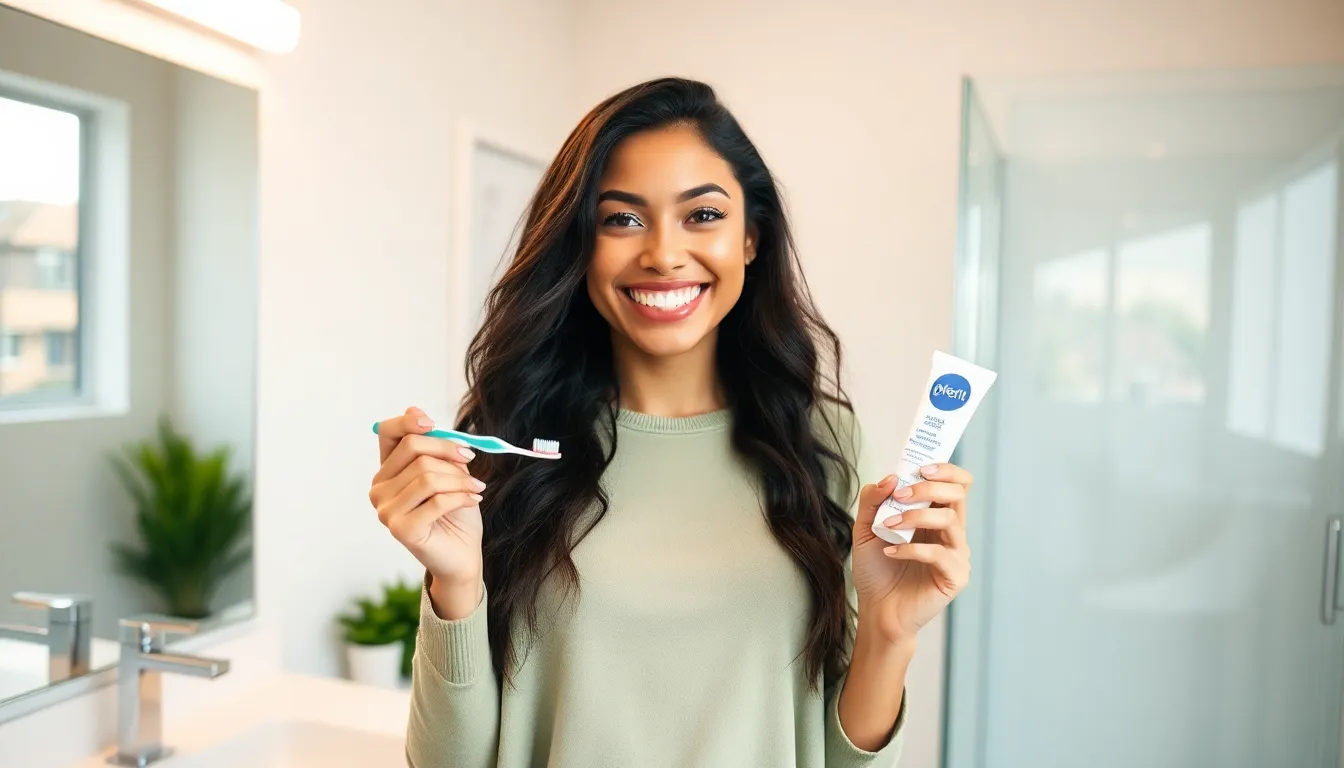
Transforming your smile doesn’t always require professional intervention. At-home teeth whitening methods offer accessible, affordable options for maintaining dental brightness between professional treatments or as standalone answers for achieving that coveted sparkle.
Regular Oral Hygiene Practices
Consistent oral hygiene forms the foundation of a dazzling smile. Brushing your teeth at least twice daily with fluoride toothpaste effectively removes plaque and surface stains that dull your teeth’s natural shine. Complement brushing with daily flossing to eliminate food particles and plaque between teeth where discoloration often begins.
Timing matters significantly when it comes to brushing after consuming acidic foods or beverages. Wait approximately 30 minutes before brushing to prevent damaging enamel that’s temporarily softened by acid exposure. This simple adjustment protects your enamel’s natural reflective properties that contribute to tooth sparkle.
Oil pulling, an ancient practice involving swishing coconut or sesame oil in your mouth for 10-20 minutes, reduces bacteria and naturally enhances teeth whiteness. Many patients report noticing subtle improvements in tooth brightness after incorporating this technique into their morning routine.
Dietary modifications directly impact tooth appearance. Reducing consumption of staining agents like coffee, tea, red wine, and dark sodas prevents yellowing and persistent stains. Dr. Harris notes, “I’ve seen remarkable improvements in patients who simply cut back on their daily coffee consumption for just two weeks.”
Over-the-Counter Whitening Products
Retail whitening products provide convenient options for improving your smile’s brightness at home. These products typically contain hydrogen peroxide or carbamide peroxide as active bleaching agents in varying concentrations.
Whitening toothpastes contain mild abrasives like baking soda that polish away surface stains while delivering chemical agents that lighten tooth color. These products work gradually, with results becoming visible after consistent use over several weeks.
Whitening strips adhere directly to teeth, delivering peroxide-based bleaching agents to the enamel surface. These products typically require daily application for 30 minutes over a 1-2 week period. Many users experience noticeable results after completing a full treatment cycle.
Gel trays and paint-on whitening gels offer more targeted application. Pre-filled trays contour to your teeth, while paint-on options allow precise application to exact stained areas. These products generally produce visible results within 7-14 days of consistent use.
A patient of Dr. Harris recently shared: “After trying professional whitening, I maintain my results with whitening strips every few months. This combination keeps my smile bright without breaking my budget.”
Natural Remedies and DIY Answers
Natural whitening alternatives appeal to those seeking chemical-free approaches to dental brightness. These methods often use common household ingredients with mild whitening properties.
Baking soda mixed with hydrogen peroxide creates an effective whitening paste. Apply this mixture to your teeth for 1-2 minutes, twice daily for up to one week to reduce surface stains. The mild abrasiveness of baking soda combined with hydrogen peroxide’s natural bleaching action provides gentle yet effective whitening.
Activated charcoal has gained popularity for its stain-absorbing properties. Brushing with activated charcoal toothpaste or powder helps remove surface discoloration, though Dr. Harris cautions, “While effective for some patients, charcoal’s abrasiveness means it should be used sparingly to protect enamel integrity.”
Apple cider vinegar serves as an occasional rinse for mild whitening effects. Always dilute it with water and limit use to once weekly to prevent enamel erosion from its acidic properties.
Certain fruits contain natural acids that help brighten teeth. Strawberries, rich in malic acid, can be mashed and applied to teeth briefly for a natural whitening effect. A patient reported noticeable brightening after applying a strawberry mixture twice weekly for a month, though Dr. Harris recommends rinsing thoroughly afterward to prevent acid damage.
Incorporating crunchy fruits and vegetables like apples, carrots, and celery into your diet naturally cleans teeth while stimulating saliva production, which helps protect enamel and maintain its natural shine.
Daily Habits for Maintaining Your Bright Smile
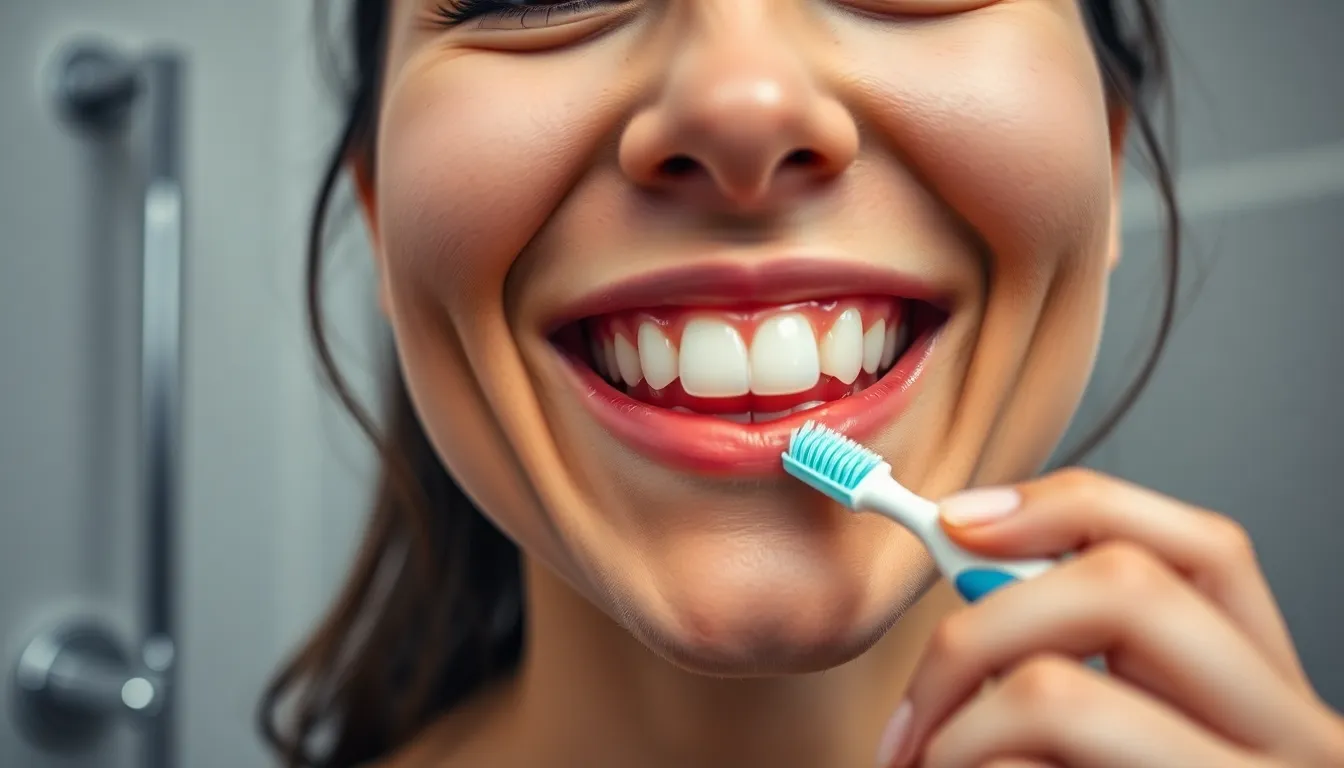
Achieving sparkling teeth requires consistent daily care and attention to oral hygiene. Establishing effective routines protects your enamel and prevents stain buildup that can dull your smile over time.
Proper Brushing and Flossing Techniques
Brushing your teeth twice daily with fluoride toothpaste forms the foundation of a bright smile. Always use a soft-bristled toothbrush to clean your teeth gently but thoroughly, as abrasive brushing can damage enamel and reduce natural shine. Nighttime brushing deserves special attention since it removes accumulated food debris and bacteria that would otherwise sit on your teeth for hours. Flossing daily reaches between teeth where brushing can’t, eliminating plaque and food particles that lead to discoloration when left untreated. Many patients report seeing noticeable improvements in their smile’s brightness after simply correcting their brushing technique. Incorporating a fluoride mouthwash into your routine helps rinse away remaining debris while strengthening enamel integrity. Dr. Harris notes, “Patients often focus on whitening products but overlook the dramatic difference proper brushing technique makes—I’ve seen transformations in smile brightness from technique correction alone.”
Foods That Help Keep Teeth White
Certain foods naturally maintain and enhance your smile’s sparkle through mechanical cleaning and nutrient support. Crunchy fruits and vegetables like apples, carrots, and celery act as natural tooth scrubbers, removing surface stains while you eat. Dairy products contribute significantly to tooth brightness by providing calcium that strengthens enamel structure. Drinking water throughout your day serves as a continuous rinse for your mouth, washing away stain-causing bacteria and pigments before they settle on teeth surfaces. One patient of Dr. Harris experienced remarkable improvement in her smile’s brightness after adding crunchy vegetables to her daily lunch and increasing water consumption. Limiting consumption of heavily pigmented items such as coffee, tea, and red wine prevents new stains from forming on your teeth. Sugar-free gum stimulates saliva production, creating a natural defense system that protects your teeth from staining agents and acids that dull enamel.
When to See a Dentist About Tooth Discoloration

Recognizing when tooth discoloration requires professional attention helps prevent minor issues from developing into serious dental problems. Certain changes in your teeth’s appearance signal it’s time to schedule a dental appointment rather than relying solely on at-home remedies.
Gray tints developing in one or more teeth often indicate underlying trauma or internal decay that needs immediate professional evaluation. These changes can signal nerve damage within the tooth that won’t respond to typical whitening methods.
Sudden color changes without an obvious cause warrant prompt dental attention, as they frequently point to infections or nerve damage requiring specialized treatment. Dr. Todd B. Harris notes, “Many patients ignore gradual discoloration but become concerned when a tooth changes color rapidly—this is actually your tooth sending an urgent message that something’s wrong internally.”
Persistent stains that don’t improve with regular brushing or whitening products typically require professional intervention. These stubborn discolorations often stem from factors beyond surface staining, such as medication effects or internal tooth issues.
Signs of enamel erosion or increased sensitivity demand professional care since tooth enamel cannot regenerate naturally. A dentist can provide protective treatments to prevent further damage and address sensitivity while improving appearance.
Recently, a patient named Sarah visited our clinic after noticing one of her front teeth darkening gradually over several months. Even though trying various whitening products, the discoloration persisted. Examination revealed a previous injury had damaged the tooth’s nerve, requiring root canal therapy and internal bleaching to restore her smile’s brightness.
Professional dental treatments for discoloration include:
- Thorough cleaning to remove surface stains and tartar buildup
- Professional whitening procedures using higher-concentration agents than available over-the-counter
- Restorative options like veneers or bonding for severe discoloration
- Internal bleaching techniques specifically for non-vital teeth with nerve damage
Regular dental checkups every six months allow for early detection of potential discoloration causes before they become more noticeable and difficult to treat. Your dentist can identify issues like chromogenic bacteria—which cause orange, yellow, or black lines near the gumline—and remove them during routine cleanings.
Potential Risks of Teeth Whitening
Teeth whitening procedures offer a path to that coveted sparkling smile, but understanding potential risks helps you make informed decisions about your dental care. Several side effects can occur during or after whitening treatments, ranging from mild discomfort to more concerning issues that require professional attention.
Tooth Sensitivity
Tooth sensitivity ranks as the most common side effect of whitening treatments, affecting many patients who pursue brighter smiles. Whitening agents like hydrogen peroxide and carbamide peroxide penetrate through tooth enamel to reach the dentin layer where nerves reside. Your teeth might react with sharp, temporary pain when exposed to hot, cold, sweet, or acidic foods and beverages after treatment. Dr. Todd B. Harris notes, “I’ve treated patients who experience important sensitivity during whitening, but reassure them that these symptoms typically subside within 24-48 hours after completing treatment.” Managing this discomfort involves using desensitizing toothpaste, fluoride rinses, or taking over-the-counter pain relievers as needed. Persistent sensitivity lasting more than a few days merits a follow-up with your dentist to rule out underlying issues.
Gum Irritation
Gum tissue often becomes irritated when exposed to whitening agents, creating redness, swelling, and tenderness along the gumline. At-home whitening kits pose particular challenges because improperly fitted trays allow bleaching gel to contact sensitive gum tissue directly. Custom-fitted trays from dental professionals minimize this risk by providing better protection for your gums. Most irritation resolves naturally within a few days, with saltwater rinses offering temporary relief. Patients with existing gum disease face higher risks of experiencing more severe irritation during whitening procedures, making professional consultation essential before beginning any whitening regimen.
Enamel Damage
Enamel damage occurs when whitening products are used incorrectly or too frequently, compromising your tooth’s protective outer layer. This mineralized surface shields teeth from decay and sensitivity, making its preservation crucial for long-term dental health. Overuse of whitening products can erode enamel, leading to increased transparency, greater sensitivity, and eventually more vulnerability to decay. One patient shared with Dr. Harris: “After using whitening strips daily for months seeking the perfect white smile, my teeth became so sensitive I couldn’t drink room temperature water without pain.” Professional guidance ensures appropriate product selection and frequency of use, protecting your enamel while still achieving desirable whitening results.
Over-Whitening and Tissue Damage
Over-whitening creates an unnatural appearance when teeth become excessively white or develop a translucent, bluish tinge at the edges. This artificial look, sometimes called “chiclet teeth,” results from repeated whitening sessions without adequate breaks. Tissue damage represents another concern, particularly with DIY whitening methods. Bleaching agents can cause chemical burns or blisters on gums, lips, and other oral tissues when applied incorrectly. These injuries typically heal within days but can be painful and increase infection risk. Professional supervision dramatically reduces these risks by ensuring proper application techniques and appropriate treatment intervals.
Before pursuing that sparkling smile through teeth whitening, consulting with a dental professional helps identify your exact risk factors and determine the safest approach for your unique dental situation. Your dental health history, existing restorations, and current oral conditions all influence how your teeth might respond to whitening treatments.
Conclusion
Your sparkling smile is within reach with the right approach to dental care. By understanding the science behind enamel health and implementing proper daily habits you’ll protect your teeth from staining agents while improving their natural brilliance.
Whether you choose professional treatments or at-home methods remember that consistency is key. Protect your investment by maintaining excellent oral hygiene making smart dietary choices and staying hydrated.
Don’t hesitate to consult with your dentist when needed especially if you notice unusual discoloration or sensitivity. With informed choices and regular care your radiant smile will continue to make lasting impressions wherever you go.
Your sparkling teeth aren’t just about aesthetics—they’re a reflection of your overall health and confidence that truly lights up a room.
Frequently Asked Questions
What causes teeth to lose their whiteness?
Teeth lose whiteness due to several factors including consumption of staining foods and beverages (coffee, tea, red wine), tobacco use, poor oral hygiene, and certain medications. The natural aging process also contributes as enamel thins over time, revealing the yellowish dentin underneath. Additionally, enamel erosion from acidic foods and drinks reduces teeth’s reflective properties, making them appear duller.
How effective are professional teeth whitening treatments compared to at-home methods?
Professional teeth whitening treatments deliver more dramatic and faster results than at-home methods. In-office treatments use higher-concentration bleaching agents under dental supervision, often enhanced by laser or LED technology. These treatments can lighten teeth by several shades in a single session, while at-home methods typically produce more gradual results over extended periods and may not be as effective for severe discoloration.
Can natural remedies like baking soda and activated charcoal really whiten teeth?
Natural remedies can provide mild whitening effects. Baking soda acts as a gentle abrasive that can remove surface stains, while activated charcoal may help absorb staining compounds. However, these methods are less effective than professional or commercial whitening products and may potentially damage enamel if used too frequently or aggressively. Results vary significantly between individuals and are typically subtle rather than dramatic.
How often should I whiten my teeth?
Professional teeth whitening should generally be done once or twice a year, depending on your dentist’s recommendation. For at-home whitening products, follow package instructions—typically every 6-12 months for treatments like strips or trays. Whitening toothpaste can be used daily or alternated with regular toothpaste. Overwhitening can damage enamel and cause sensitivity, so it’s important not to exceed recommended frequencies.
What foods help keep teeth white naturally?
Crunchy fruits and vegetables like apples, carrots, and celery act as natural teeth scrubbers, removing plaque and surface stains while stimulating saliva production. Dairy products like cheese and yogurt contain calcium that strengthens enamel and lactic acid that helps prevent decay. Strawberries contain malic acid that naturally whitens, while water helps wash away stain-causing agents and maintains saliva levels for neutralizing acids.
How can I prevent tooth sensitivity during whitening?
To prevent tooth sensitivity during whitening, use desensitizing toothpaste for two weeks before treatment, choose products with lower peroxide concentrations, follow instructions carefully, and avoid overuse. Take breaks between whitening sessions to allow teeth to recover. Professional treatments often include desensitizing agents. If sensitivity occurs, temporarily discontinue whitening and consult your dentist who may recommend fluoride treatments or special toothpastes.
When should I see a dentist about tooth discoloration?
See a dentist if you notice gray tints or sudden color changes, which may indicate trauma or decay. Consult a professional when persistent stains don’t respond to at-home treatments, if you experience increased tooth sensitivity, or notice signs of enamel erosion. Discoloration accompanied by pain requires immediate attention. Regular dental checkups are essential for early detection of issues that might affect tooth color.
Can over-whitening damage my teeth?
Yes, over-whitening can damage teeth. Excessive use of whitening products can erode enamel, increasing sensitivity and vulnerability to decay. It may cause gum irritation, create an unnatural “chalky” appearance, and potentially lead to translucent tooth edges. Following product instructions and consulting with a dental professional before beginning any whitening regimen helps prevent these issues while achieving desired results safely.

